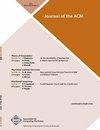均衡分配与噪声的选择
IF 2.5
2区 计算机科学
Q2 COMPUTER SCIENCE, HARDWARE & ARCHITECTURE
引用次数: 0
摘要
我们考虑将m个球(作业)分配到n个箱(服务器)中。在标准的two - choice过程中,在每一步t = 1,2,…,m,我们首先对两个随机选择的箱子进行抽样,比较它们的两个载荷,然后将一个球放入载荷最少的箱子中。众所周知,对于任意m≥n,这将导致log 2 log n + Θ(1)的缺口(最大和平均负载之间的差)(具有高概率)。在这项工作中,我们考虑了两种选择在不同的设置与噪声负载比较。一个关键的设置涉及到一个自适应的对手,它的能力受到一些阈值的限制\(g \in \mathbb {N} \)。在每一步中,这样的对手可以确定负载相差不超过g的两个箱子之间的任何负载比较的结果,如果负载差大于g,则比较是正确的。对于这种对抗性设置,我们首先证明了对于任意m≥n,间隙大概率为\(\mathcal {O}(g+\log n) \)。然后通过精细分析证明,当g≤log n时,则对于任意m≥n,间隙为\(\mathcal {O}(\frac{g}{\log g} \cdot \log \log n) \)。对于g的恒定值,这推广了[19,61]对Two-Choice过程的重负载分析,并建立了即使“相似负载”的箱子之间的负载比较是错误的,也能渐进地保持相同的间隙界。最后,我们用严格的下界来补充这些上界,这建立了一个有趣的关于参数g如何影响间隙的相变。该分析也适用于信息过时和延迟的设置。例如,对于[18]的设置,其中球以大小为b = n的连续批次分配,我们提出了改进的紧密间隙界\(\Theta \big (\frac{\log n}{\log \log n}\big) \)。此界限还扩展到b值的范围,并应用于一个宽松的设置,其中报告的存储库负载可以是最后b步中的任何负载值。本文章由计算机程序翻译,如有差异,请以英文原文为准。
Balanced Allocations with the Choice of Noise
We consider the allocation of m balls (jobs) into n bins (servers). In the standard Two-Choice process, at each step t = 1, 2, …, m we first sample two randomly chosen bins, compare their two loads and then place a ball in the least loaded bin. It is well-known that for any m ≥ n , this results in a gap (difference between the maximum and average load) of log 2 log n + Θ (1) (with high probability). In this work, we consider Two-Choice in different settings with noisy load comparisons. One key setting involves an adaptive adversary whose power is limited by some threshold \(g \in \mathbb {N} \) . In each step, such adversary can determine the result of any load comparison between two bins whose loads differ by at most g , while if the load difference is greater than g , the comparison is correct. For this adversarial setting, we first prove that for any m ≥ n the gap is \(\mathcal {O}(g+\log n) \) with high probability. Then through a refined analysis we prove that if g ≤ log n , then for any m ≥ n the gap is \(\mathcal {O}(\frac{g}{\log g} \cdot \log \log n) \) . For constant values of g , this generalizes the heavily loaded analysis of [19, 61] for the Two-Choice process, and establishes that asymptotically the same gap bound holds even if load comparisons among “similarly loaded” bins are wrong. Finally, we complement these upper bounds with tight lower bounds, which establish an interesting phase transition on how the parameter g impacts the gap. The analysis also applies to settings with outdated and delayed information. For example, for the setting of [18] where balls are allocated in consecutive batches of size b = n , we present an improved and tight gap bound of \(\Theta \big (\frac{\log n}{\log \log n}\big) \) . This bound also extends for a range of values of b and applies to a relaxed setting where the reported load of a bin can be any load value from the last b steps.
求助全文
通过发布文献求助,成功后即可免费获取论文全文。
去求助
来源期刊

Journal of the ACM
工程技术-计算机:理论方法
CiteScore
7.50
自引率
0.00%
发文量
51
审稿时长
3 months
期刊介绍:
The best indicator of the scope of the journal is provided by the areas covered by its Editorial Board. These areas change from time to time, as the field evolves. The following areas are currently covered by a member of the Editorial Board: Algorithms and Combinatorial Optimization; Algorithms and Data Structures; Algorithms, Combinatorial Optimization, and Games; Artificial Intelligence; Complexity Theory; Computational Biology; Computational Geometry; Computer Graphics and Computer Vision; Computer-Aided Verification; Cryptography and Security; Cyber-Physical, Embedded, and Real-Time Systems; Database Systems and Theory; Distributed Computing; Economics and Computation; Information Theory; Logic and Computation; Logic, Algorithms, and Complexity; Machine Learning and Computational Learning Theory; Networking; Parallel Computing and Architecture; Programming Languages; Quantum Computing; Randomized Algorithms and Probabilistic Analysis of Algorithms; Scientific Computing and High Performance Computing; Software Engineering; Web Algorithms and Data Mining
 求助内容:
求助内容: 应助结果提醒方式:
应助结果提醒方式:


